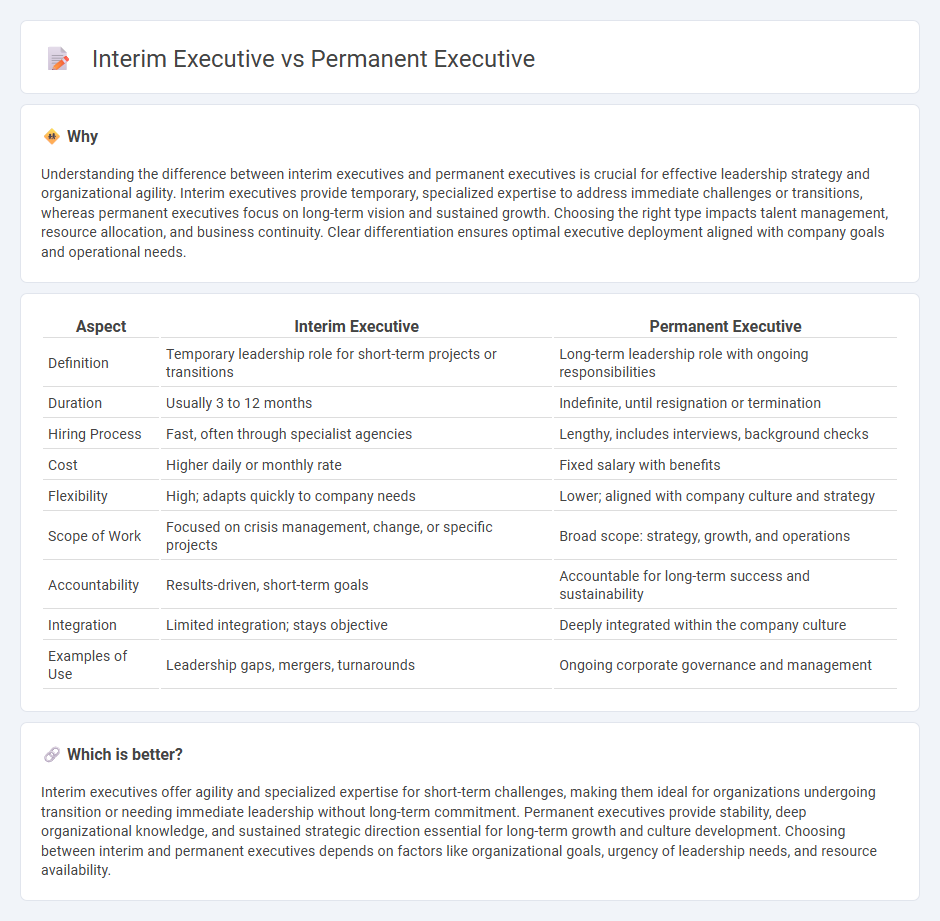
Interim executives provide specialized management expertise for short-term projects or transitional phases, ensuring agility and immediate impact without long-term commitments. Permanent executives focus on sustained strategic leadership, fostering organizational growth and culture continuity over an extended period. Discover how selecting the right executive type can optimize your management strategy.
Why it is important
Understanding the difference between interim executives and permanent executives is crucial for effective leadership strategy and organizational agility. Interim executives provide temporary, specialized expertise to address immediate challenges or transitions, whereas permanent executives focus on long-term vision and sustained growth. Choosing the right type impacts talent management, resource allocation, and business continuity. Clear differentiation ensures optimal executive deployment aligned with company goals and operational needs.
Comparison Table
| Aspect | Interim Executive | Permanent Executive |
|---|---|---|
| Definition | Temporary leadership role for short-term projects or transitions | Long-term leadership role with ongoing responsibilities |
| Duration | Usually 3 to 12 months | Indefinite, until resignation or termination |
| Hiring Process | Fast, often through specialist agencies | Lengthy, includes interviews, background checks |
| Cost | Higher daily or monthly rate | Fixed salary with benefits |
| Flexibility | High; adapts quickly to company needs | Lower; aligned with company culture and strategy |
| Scope of Work | Focused on crisis management, change, or specific projects | Broad scope: strategy, growth, and operations |
| Accountability | Results-driven, short-term goals | Accountable for long-term success and sustainability |
| Integration | Limited integration; stays objective | Deeply integrated within the company culture |
| Examples of Use | Leadership gaps, mergers, turnarounds | Ongoing corporate governance and management |
Which is better?
Interim executives offer agility and specialized expertise for short-term challenges, making them ideal for organizations undergoing transition or needing immediate leadership without long-term commitment. Permanent executives provide stability, deep organizational knowledge, and sustained strategic direction essential for long-term growth and culture development. Choosing between interim and permanent executives depends on factors like organizational goals, urgency of leadership needs, and resource availability.
Connection
Interim executives bridge organizational gaps by providing immediate leadership during transitions, ensuring continuity and stability. Permanent executives benefit from this period as interim leaders implement strategic changes and maintain operations, setting a foundation for long-term success. Both roles align through shared objectives of driving performance and sustaining corporate growth.
Key Terms
Tenure
Permanent executives typically have an indefinite tenure, allowing for long-term strategic planning and continuous leadership within an organization. Interim executives serve for a fixed period, often ranging from a few months to a year, providing immediate expertise during transitions or crises. Discover more about how tenure impacts executive effectiveness and organizational stability.
Continuity
Permanent executives provide long-term stability and strategic continuity by embedding themselves within the company's culture and vision, ensuring consistent leadership and aligned decision-making. Interim executives offer critical short-term expertise and agility during transitions or crises, maintaining operational continuity while permanent leadership is recruited. Explore the key differences in continuity management and how each role supports organizational resilience.
Transition
Permanent executives provide long-term leadership stability and strategic continuity during organizational transitions, ensuring sustained growth and cultural alignment. Interim executives offer specialized expertise and immediate decision-making support for critical transition periods, facilitating seamless change management and risk mitigation. Explore how each executive type can optimize your company's transition efficiency and success.
Source and External Links
Permanent secretary - Wikipedia - A permanent secretary is the most senior civil servant in a department or ministry, responsible for day-to-day activities and providing advice to political leaders.
Difference between Political and Permanent Executive - The permanent executive consists of civil servants who assist political executives in implementing policies and decisions.
Distinguish between Political Executive and Permanent Executive - Permanent executives are civil servants appointed through competitive exams, serving long-term roles distinct from the politically appointed executives.
 dowidth.com
dowidth.com